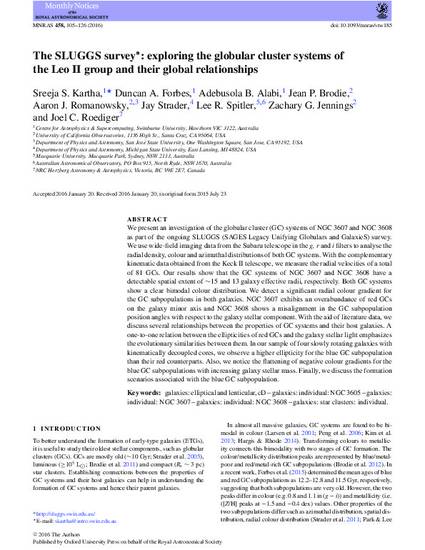
Article
The SLUGGS survey*: exploring the globular cluster systems of the Leo II group and their global relationships
Monthly Notices of the Royal Astronomical Society
(2016)
Abstract
We present an investigation of the globular cluster (GC) systems of NGC 3607 and NGC 3608 as part of the ongoing SLUGGS (SAGES Legacy Unifying Globulars and GalaxieS) survey. We use wide-field imaging data from the Subaru telescope in the g, r and i filters to analyse the radial density, colour and azimuthal distributions of both GC systems. With the complementary kinematic data obtained from the Keck II telescope, we measure the radial velocities of a total of 81 GCs. Our results show that the GC systems of NGC 3607 and NGC 3608 have a detectable spatial extent of ∼15 and 13 galaxy effective radii, respectively. Both GC systems show a clear bimodal colour distribution. We detect a significant radial colour gradient for the GC subpopulations in both galaxies. NGC 3607 exhibits an overabundance of red GCs on the galaxy minor axis and NGC 3608 shows a misalignment in the GC subpopulation position angles with respect to the galaxy stellar component. With the aid of literature data, we discuss several relationships between the properties of GC systems and their host galaxies. A one-to-one relation between the ellipticities of red GCs and the galaxy stellar light emphasizes the evolutionary similarities between them. In our sample of four slowly rotating galaxies with kinematically decoupled cores, we observe a higher ellipticity for the blue GC subpopulation than their red counterparts. Also, we notice the flattening of negative colour gradients for the blue GC subpopulations with increasing galaxy stellar mass. Finally, we discuss the formation scenarios associated with the blue GC subpopulation.
Keywords
- galaxies: elliptical and lenticular,
- cD,
- galaxies: individual: NGC 3605,
- galaxies: individual: NGC 3607,
- galaxies: individual: NGC 3608,
- galaxies: star clusters: individual
Disciplines
Publication Date
May, 2016
DOI
10.1093/mnras/stw185
Publisher Statement
This article has been accepted for publication in Monthly Notices of the Royal Astronomical Society ©: 2016 The Authors. Published by Oxford University Press on behalf of the Royal Astronomical Society. All rights reserved.
This article is also available online at the following link: http://dx.doi.org/10.1093/mnras/stw185
Citation Information
Sreeja S. Kartha, Duncan A. Forbes, Adebusola B. Alabi, Jean P. Brodie, et al.. "The SLUGGS survey*: exploring the globular cluster systems of the Leo II group and their global relationships" Monthly Notices of the Royal Astronomical Society Vol. 458 Iss. 1 (2016) p. 105 - 126 ISSN: 1365-2966 Available at: http://works.bepress.com/aaron_romanowsky/93/
